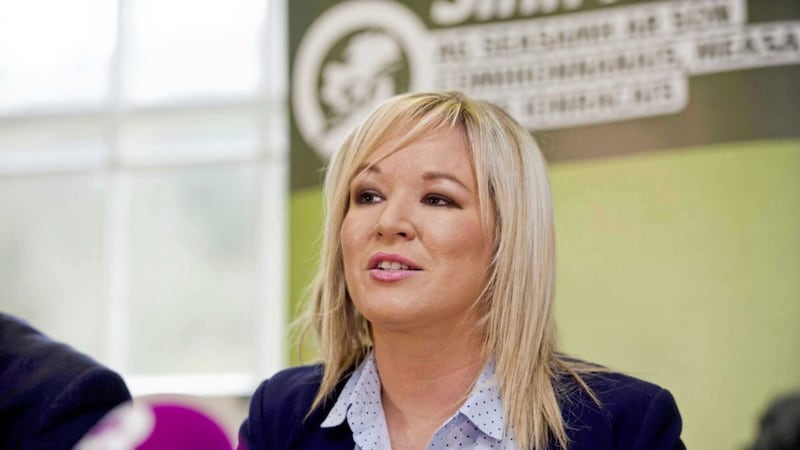Sinn Féin has added a few more details to its plan B in Stormont’s absence.
Since January, it has cited a letter signed by Tony Blair and Bertie Ahern in the run-up to the 2006 St Andrew’s agreement, warning the DUP that if those talks failed to restore devolution there would be “joint stewardship of the process”, based around the north-south and east west “structures and functions” of the Good Friday Agreement.
Sinn Féin has described this as “a form of joint authority”, with Gerry Adams insisting the 2006 letter is still “live”.
Now the party has specified one of those structures, the Belfast-based British-Irish Intergovernmental Conference (BIIG), as Stormont’s de facto replacement. Michelle O’Neill says it “should meet as soon as possible” to “honour outstanding commitments and to deliver rights enjoyed by everyone else on these islands.”
Observers have noted how muted Sinn Féin was in this demand, given its implications.
That is presumably because Stormont is coming back. Sinn Féin is also restricted in how much it can complain about the secretary of state’s budget this week, despite his unexpected reference to DUP-Tory cash. Having insisted direct rule is “unacceptable”, republicans would look impotent denouncing the budget as direct rule while still having to accept it.
Another problem with Sinn Féin’s demand is that it steps outside the Good Friday Agreement. BIIG, which replaced the London-Dublin structures of the 1985 Anglo-Irish Agreement, is only tasked with discussing non-devolved matters.
It can assume oversight of devolved matters under direct rule - but of course, Sinn Féin has declared that unacceptable.
So there is still a Stormont-sized hole in the system. Far from ‘honouring outstanding commitments’, expecting BIIG to pass an Irish language act over Stormont’s head, for example, would be a fundamental breach. The agreement also states that BIIG’s operation will involve “no derogation from the sovereignty of either government”.
The Stormont-shaped hole pops up elsewhere too, perhaps explaining why Sinn Féin has not mentioned the agreement’s other east-west structure. The British-Irish Council (BIC) comprises both governments, the devolved administrations and the crown dependencies.
Nor has Sinn Féin mentioned the only north-south structure, the North-South Ministerial Council (NSMC) and its cross-border bodies, because that would invite jeers about leaving the north without ministers.
Establishing a precursor to NSMC was the row that wrecked the 1973 Sunningdale Agreement, damning us to 30 more years of violence. Unionists bitterly opposed its resurrection in 1998, yet now republicans are in the absurd position of locking everyone out of the agreed all-Ireland structure.
Just as well Stormont is likely to return - the DUP and Sinn Féin conferences should clarify prospects. But even after that happens, the other structures of the agreement deserve renewed attention.
As well as providing a general guarantee and safety valve on devolution, they are the perfect vehicles to address Brexit and border issues, which are set to put Stormont under years of further pressure.
The reason Brexit is so toxic to devolution is that all Stormont can do is argue about it - most of the decisions required are outside its control. Customs, immigration, trade deals, international relations, the common travel area and border security remain vested in London, making BIIG rather than Stormont the agreed forum to discuss them.
East-west and north-south EU issues are specified in the agreement as the remit of BIC and NSMC respectively (which does not mean Brexit breaches the agreement, only that the issues will change.)
The inclusion of the Isle of Man and the Channel Islands in BIC has sometimes made it seem less than serious. Suddenly, those territories’ special customs arrangements with the EU help make BIC relevant.
Drawing Stormont ministers more deeply into these structures would, frankly, force them to play with the grown-ups.
The main obstacle to this could be getting the grown-ups to appear. BIIG is meant to have regular summits but has not met since 2007, when London decided it would just speak to Dublin directly.
BIC still meets twice a year but Theresa May has never considered it worth attending.
North-south structures were created as a concession to unionists, so a demand for their use from republicans can attract no credible objections.
Sinn Féin might try to portray BIIG a form of joint authority. However, under current parliamentary arithmetic, a meeting of the British and Irish governments is a meeting of Sinn Féin’s opponents in Dublin and the DUP’s partners in London.
Any unionist who finds this threatening has not thought the matter through.
newton@irishnews.com









